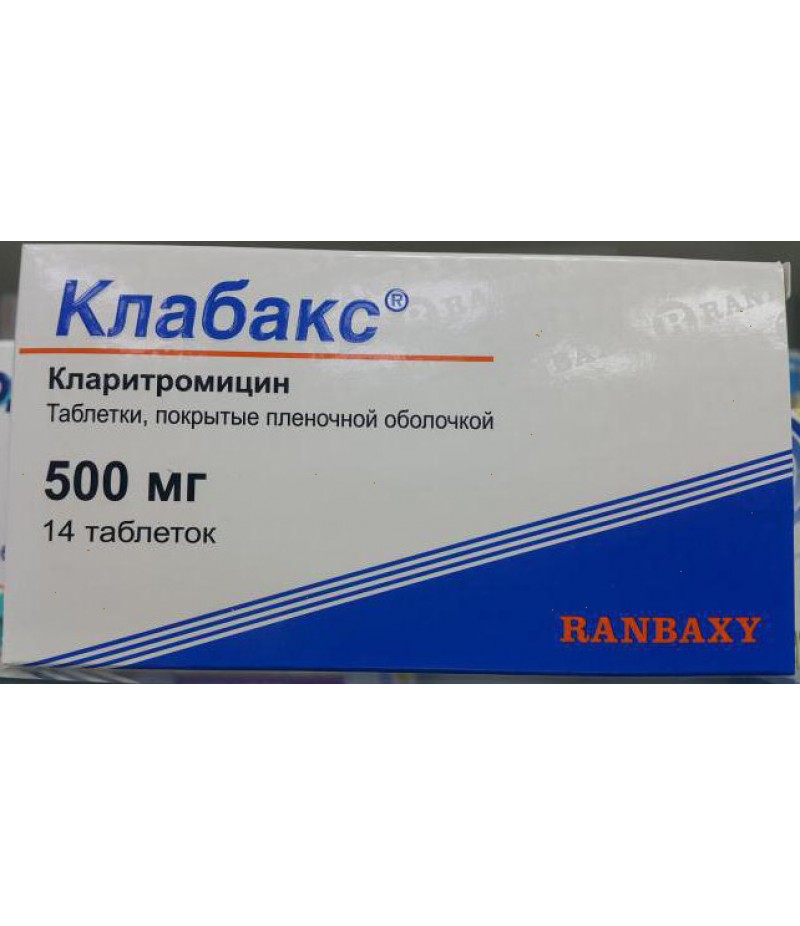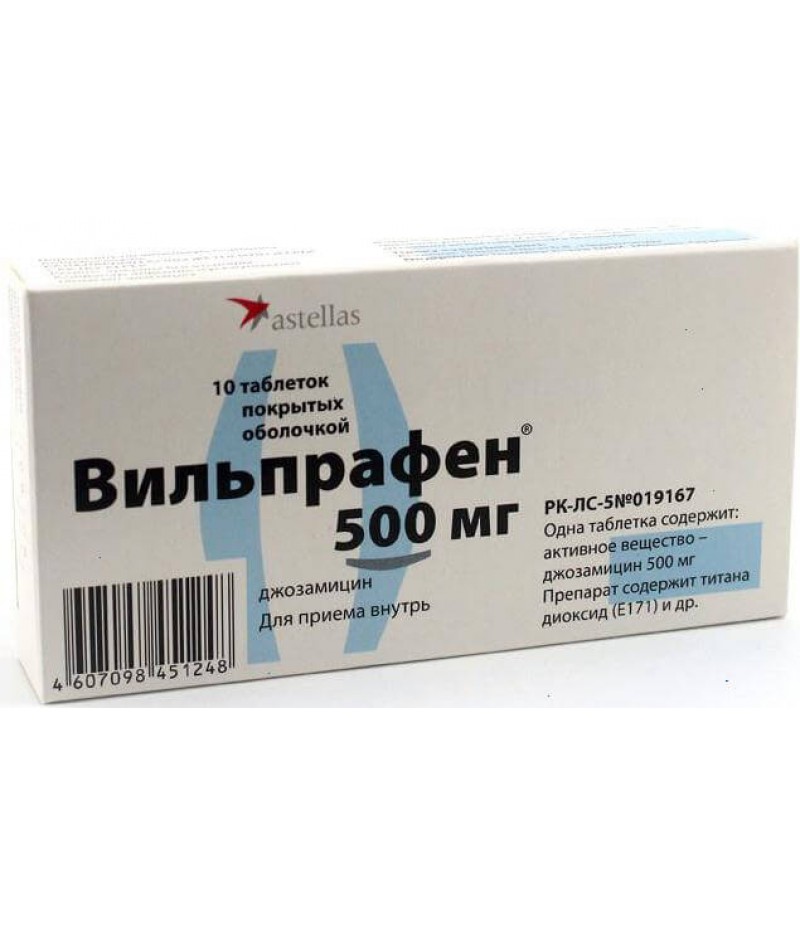Clarithromycin tabs 500mg #14
- $23.28
- 3 or more $22.86
- Availability:In Stock
Clarithromycin user manualYou can buy Clarithromycin on this pageCompositionThe composition of the Clarithromycin tablets includes the active component of Clarithromycin, as well as additional components: MCC, potato starch, prege..
Tags: tabs
Clarithromycin user manual
You can buy Clarithromycin on this page
Composition
The composition of the Clarithromycin tablets includes the active component of Clarithromycin, as well as additional components: MCC, potato starch, pregelatinized starch, low molecular weight PVP, colloidal silicon dioxide, magnesium stearate, sodium lauryl sulfate.
Clarithromycin also contains the active substance Clarithromycin, as well as additional components: corn starch, lactose monohydrate, povidone, croscarmellose sodium, calcium stearate, polysorbate 80. The hard capsule consists of gelatin, as well as titanium dioxide.
Form of issue
The antibiotic is made in the form of tablets and capsules. The tablets are yellow, covered with a membrane, a form of biconvex, oval. On a break two layers are looked through. The package contains 7, 10 or 14 tablets. Capsules - white, from gelatin, firm. Inside the powder or a dense white (can be yellowish) mass is contained. The package contains 7, 10 or 14 capsules.
pharmachologic effect
Refers to the group of macrolides of a wide range of effects. Under its influence in the body, the process of protein synthesis of microorganisms is disrupted. The active substance binds to the 50S subunit of the microbial cell ribosome membrane. Clarithromycin affects pathogens located intracellularly, as well as outside cells. Demonstrates activity in relation to such microorganisms:
Gram-positive aerobic microorganisms (Streptococcus agalactiae, Staphylococcus aureus (demonstrating sensitivity to Streptococcus pyogenes, methicillin), Streptococcus viridans Streptococcus pneumoniae, Listeria monocytogenes);
Gram-negative aerobic microorganisms (Neisseria gonorrhoeae, Moraxella (Branhamella) catarrhal is, Haemophilus parainfluenzae, Haemophilus influenza, Legionella pneumophila, Campylobacter jejuni, Helicobacter pylori, Bordetella pertussis);
anaerobic bacteria (Propionibacterium acnes, Clostridium perfringens, Bacteroides fragilis, Peptostreptococcus species, Peptococcus species);
intracellular microorganisms (Ureaplasma urealyticum, Chlamydia pneumonia, Mycoplasma pneumonia, Mycobacterium leprae, M.fortitum, Chlamydia trachomatis, M. marinum, Mycobacterium avium, M. chelonae, M. kansaii);
is active with respect to Toxoplasma species.
Clarithromycin also exhibits bactericidal activity against a number of bacterial strains: Streptococcus pneumonia, H. pylori and Campylobacter spp., Haemophilus influenzae, Streptococcus agalactiae, Streptococcus pyogenes, Neisseria gonorrhoeae, Moraxella (Branhamella) catarrhalis.
Pharmacokinetics and pharmacodynamics
Active component, getting into the body, quickly absorbed. Eating slows down the absorption process, but does not significantly affect the bioavailability of the medication. More than 90% associated with plasma proteins. After Clarithromycin was taken once, two peaks of maximum concentration were noted. The appearance of the second peak is due to the fact that the substance is concentrated in the gallbladder and then enters the intestine where it is absorbed.
The greatest concentration when ingestion of 250 mg of the drug is observed after 1-3 hours.
20% of the ingested dose is hydroxylated in the liver, resulting in the formation of the main metabolite, 14-hydroxyClarithromycin. This substance shows a pronounced antimicrobial activity against Haemophilus influenzae. This metabolite is an inhibitor of isoenzymes CYP3A4, CYP3A5, CYP3A7.
If the intake is carried out regularly for 250 mg of medication per day, the concentrations of the active substance and its main metabolite, respectively, are 1 and 0.6 μg / ml, respectively. The half-life is 3-4 and 5-6 hours, respectively. Clarithromycin accumulates in therapeutic concentrations in the skin, lungs, soft tissues.
It is excreted from the body with urine, as well as with feces.
Indications for use
Clarithromycin is prescribed for the treatment of infectious and inflammatory diseases caused by pathogens that exhibit sensitivity to Clarithromycin. The following indications for the use of the drug are determined:
infectious diseases of the ENT organs of the upper and respiratory tract (otitis media, tonsillopharyngitis, sinusitis);
infectious diseases of the lower respiratory tract (pneumonia, bronchitis - chronic and acute);
mycobacterial infections;
infection of the skin and soft tissues (also used to prevent these diseases in AIDS patients);
eradication of Helicobacter pylori in people suffering from peptic ulcer (only used in combination with other agents).
Contraindications
Clarithromycin is contraindicated in such conditions and diseases:
hypersensitivity to components;
the first trimester of pregnancy;
lactation time;
simultaneous administration with Pimozide, Terfenadine, Cisapride.
Caution should take pills or capsules to people with hepatic or renal insufficiency.
Side effects
During the course of treatment, such side effects may appear:
nervous system: dizziness, fear, headache, bad dreams, insomnia, a sense of anxiety; in rare cases - hallucinations, impaired consciousness, psychosis;
Digestion: vomiting, nausea, stomatitis, gastralgia, cholestatic jaundice, glossitis, diarrhea, increased activity of hepatic transaminases, in rare cases pseudomembranous enterocolitis appears;
hemopoiesis, hemostasis system: in rare cases - thrombocytopenia;
sensory organs: a sense of noise in the ears, a violation of taste, there are isolated cases of hearing loss after the drug was canceled;
allergy: itching and rash on the skin, anaphylactoid reactions, Stevens-Johnson syndrome;
other actions: the manifestation of the resistance of microorganisms.
Instructions for use Clarithromycin (Method and dosage)
Instructions for use Clarithromycin provides that adults and children after 12 years of age take, depending on the diagnosis, 250-500 mg twice daily. The therapy lasts from 6 to 14 days.
If the patient is diagnosed with a serious infection or, for some reason, oral administration of the drug is not possible, Clarithromycin is given IV, the dose is 500 mg per day. The drug is taken for 2 to 5 days, after which, if possible, the patient is transferred to oral medication. In general, the treatment lasts up to 10 days.
If the agent is prescribed for the treatment of diseases caused by Mycobacterium avium, as well as severe infections (including those provoked by Haemophilus influenzae), a dose of 0.5-1 g twice daily is indicated. The largest daily dose is 2 g. Treatment can last about 6 months.
People with chronic renal failure receive 250 mg once a day, if a serious infection is diagnosed, 250 mg twice a day are prescribed. Treatment can last up to 14 days.
Overdose
If an overdose occurs, the patient may have problems with GI function, impaired consciousness, headaches. In such a case, the stomach is washed and, if necessary, symptomatic treatment is prescribed.
Interaction
You can not use Clarithromycin concomitantly with Pimozide, Terfenadine and Cisapride.
Admission with indirect anticoagulants, drugs that are metabolized in the liver using cytochrome P450 enzymes, as well as with Teofillin, Cisapride, Carbamazepine, Terfenadine, Rifabutin, Triazolam, Dizopyramide, Lovastatin, Cyclosporine, Midazolam, ergot alkaloids, Digoxin, Phenytoin, the concentration of these drugs in blood increases.
Clarithromycin decreases the absorption of Zidovudine.
Cross-resistance between Clarithromycin, Clindamycin and Linkomycin may develop.
Reduces the rate of metabolism of astemizole, so with simultaneous application, an increase in the QT interval may develop, the risk of ventricular arrhythmia as "pirouette" increases.
When used concomitantly with omeprazole, the concentration in blood plasma of omeprazole increases significantly and Clarithromycin insignificantly.
If the drug is used simultaneously with Pimozide, the concentration of the latter increases, which increases the likelihood of severe cardiotoxic effects.
The use of Tolbutamide increases the risk of hypoglycemia.
When applied simultaneously with fluoxetine, toxic effects are likely.
Storage conditions
Clarithromycin should be protected from moisture and light, the storage temperature should not exceed 25 ° C.
Keep away from children.
Shelf life
You can keep the medicine for 2 years. Do not apply after this time.
special instructions
If the patient is diagnosed with chronic diseases, he must necessarily control serum enzymes.
Caution means prescribe when taking medications, the metabolism of which passes in the liver.
There is a cross-resistance between antibacterial drugs that belong to the group of macrolides.
In the process of antibiotic therapy, the normal intestinal microflora changes, so the probability of superinfection, provoked by resistant microorganisms, should be taken into account.
It should be borne in mind that the manifestation of diarrhea in severe form can be associated with pseudomembranous colitis.
Children for ease of taking the drug may be prescribed a suspension, the active substance of which is Clarithromycin.
Children
In pediatrics, the drug can be used for children after 6 months of age. The most commonly used suspension for children, the active component of which is Clarithromycin. The use should be strictly according to the scheme prescribed by the doctor.
In pregnancy and lactation
In the first trimester, this antibiotic can not be used. In subsequent months of pregnancy, the use of the drug is possible only if the doctor correlates the intended use for the woman and the harm to the fetus. In the lactation period, if you need to take the medicine, you need to stop breastfeeding.
Reviews about Clarithromycin
Patients leave in the network different reviews about Clarithromycin. It is often written that with the help of an antibiotic it was possible in a few days to get rid of the symptoms of infectious diseases. However, there are many opinions about the fact that the drug provokes the manifestation of a large number of side effects, in particular, headaches, digestive problems, imbalance of the intestinal microflora. In most cases, it is noted that it is advisable to drink the medicine only according to the prescription of the doctor and according to the scheme that the specialist appointed.




